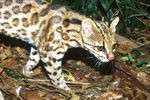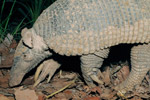In 1929, two sons of Theodore Roosevelt (Teddy Junior and Kermit) led an expedition that killed a barking deer, or muntjac, in present-day Laos, which has left scientists puzzled for over 80 years. At first scientists believed it to be a distinct species of muntjac and named it Roosevelts’ muntjac (Muntiacus rooseveltorum), however that designation was soon cast into doubt with some scientists claiming it was a specimen of an already-known muntjac or a subspecies. The problem was compounded by the fact that the animal simply disappeared in the wild. No one ever documented a living Roosevelts’ muntjac again—until now.
“The Roosevelts’ barking deer…is one of the most poorly known mammal species in the world. Since it was described as a new species in the early 20th century…no records have been reported until its rediscovery in Laos [in 1999],” write a scientific team, headed by Min Le with Hanoi University of Science, in a new paper in Conservation Genetics that has finally solved the mystery of Roosevelts’ muntjac.
All trace of Roosevelts’ muntjac vanished until 1999, when researchers found hunting trophies of the animals in Laos—though still no living animal. They conducted molecular studies on these specimens, which pointed to the fact that Roosevelts’ muntjac was indeed a distinct species.

One of the first ever photos of Roosevelts’ muntjacs. Photo taken by camera trap in Xuan Lien Nature Reserve. Photo by: Xuan Lien Nature Reserve and CRES, VNU.
“However, the taxonomic status of this species was thrown in dark again, as experts thought that the 1999 study was not convincing enough (using only mitochondrial DNA and so few samples…),” Le told mongabay.com. “Morphologically, this species could not be distinguished from other closely related species such as Truong Son muntjac, Muntiacus truongsonensis, primarily because so few specimens were available.”
Fifteen years later, and 85 years since the Roosevelt expedition bagged the original specimen, Le and his team have made a surprising discovery: Roosevelts’ muntjac, but in Vietnam not Laos. Examining hunting trophies of muntjacs in Vietnam’s Pu Hoat and Xuan Lien Nature Reserve, the team found uncanny similarities to the Roosevelt specimen, still housed in the Field Museum in Chicago.
“This was totally unexpected,” Le said. “When I first saw the data, I thought I saw a new species of muntjac in Vietnam. But after carefully compared our data with those from the type specimen, we confirmed that it is the Roosevelts’ barking deer. We were all very happy about the finding.”
Le and his team conducted thorough genetic testing on their specimens, which proved once again that Roosevelts’ muntjac is a distinct species.
“We sequenced more mitochondrial and nuclear genes of new samples. We reconstructed phylogenetic relationships of the Roosevelts’ muntjac with its relatives. Our genetic data reaffirmed that this species represents a distinct evolutionary lineage, closely related to Truong Son muntjac in the region and leaf muntjac in Myanmar,” explained Le.

A pair of Roosevelts’ muntjacs in Xuan Lien Nature Reserve. Photo by: Xuan Lien Nature Reserve and CRES, VNU.
But this wasn’t the only breakthrough in the search for the mystery muntjac. While Le and his team were conducting the genetic analyses, another team succeeded in capturing the first photos of Roosevelts’ muntjac ever. A series of shots, including some showing a pair of muntjacs, were taken by camera traps.
“The photos are very significant because they show that the species still live in the area (no one ever saw it alive since 1929!), and that there is still a chance to save it,” said Le.
Still, even as Roosevelts’ muntjac is rediscovered—and confirmed as a distinct species in its own right—it may be on its way out.
“Hunting has been escalating in [Pu Hoat and Xuan Lien Nature Reserve],” the scientists write adding that in 1999 they “documented hundreds of traps being deployed by local people in Xuan Lien Nature Reserve.”
In addition, the primary forests on which Roosevelts’ muntjac depends only cover about 10 percent of the reserves and are falling fast.
The next step, according to Le, is for researchers to conduct surveys of Roosevelts’ muntjac to determine its population size. With that information, conservationists will be able to draft an action plan.
“We need to act fast before it is too late to save this species,” he said.
Scientists are only beginning to unravel the muntjac family. Generally around 12 species are recognized, but shockingly—for good-sized mammals—half of these were discovered after 1980. In fact, five distinct species were uncovered in the 1990s alone, a decade that might be described as muntjac taxonomic madness. Of the 12 known species today, five (including Roosevelts’) are still categorized as Data Deficient by the IUCN Red List, meaning scientists don’t have enough data to know if they are threatened or not. In addition, three species are listed as Endangered and one as Vulnerable. Generally, barking deer—so-called for their distinct bark-like calls—are imperiled by overhunting, snaring, and vast forest less across Asia.

Roosevelts’ muntjac climbing a hillside. Photo by: Xuan Lien Nature Reserve and CRES, VNU.

Night shot of Roosevelts’ muntjac. Photo by: Xuan Lien Nature Reserve and CRES, VNU.
Citations:
- Minh Le,
Thanh V. Nguyen,
Ha T. Duong,
Ha M. Nguyen,
Long D. Dinh,
Tuoc Do,
Hai D. Nguyen,
George Amato . (2014) Discovery of the Roosevelt’s Barking Deer (Muntiacus rooseveltorum) in Vietnam. Conservation Genetics. doi: 810.1007/s10592-014-0581-4
Related articles
Several Amazonian tree frog species discovered, where only two existed before

(03/18/2014) We have always been intrigued by the Amazon rainforest with its abundant species richness and untraversed expanses. Despite our extended study of its wildlife, new species such as the olinguito (Bassaricyon neblina), a bear-like carnivore hiding out in the Ecuadorian rainforest, are being identified as recently as last year. In fact, the advent of efficient DNA sequencing and genomic analysis has revolutionized how we think about species diversity. Today, scientists can examine known diversity in a different way, revealing multiple ‘cryptic’ species that have evaded discovery by being mistakenly classified as a single species based on external appearance alone.
Scientists discover new whale species

(02/14/2014) Beaked whales are incredibly elusive and rare, little-known to scientists and the public alike—although some species are three times the size of an elephant. Extreme divers, beaked whales have been recorded plunging as deep as 1,800 meters (5,900 feet) for over an hour. Few of the over 20 species are well-known by researchers, but now scientists have discovered a new beaked whale to add to the already large, and cryptic, group: the pointed beaked whale (Mesoplodon hotaula).
Scientists make one of the biggest animal discoveries of the century – a new tapir

(12/16/2013) In what will likely be considered one of the biggest (literally) zoological discoveries of the Twenty-First Century, scientists today announced they have discovered a new species of tapir in Brazil and Colombia. The new mammal, hidden from science but known to local indigenous tribes, is actually one of the biggest animals on the continent, although it’s still the smallest living tapir. Described in the Journal of Mammology, the scientists have named the new tapir Tapirus kabomani after the name for ‘tapir’ in the local Paumari language: Arabo kabomani.
Scientists discover new cat species roaming Brazil

(11/27/2013) As a family, cats are some of the most well-studied animals on Earth, but that doesn’t mean these adept carnivores don’t continue to surprise us. Scientists have announced today the stunning discovery of a new species of cat, long-confused with another. Looking at the molecular data of small cats in Brazil, researchers found that the tigrina—also known as the oncilla in Central America—is actually two separate species. The new species has been dubbed Leopardus guttulus and is found in the Atlantic Forest of southern Brazil, while the other Leopardus tigrinus is found in the cerrado and Caatinga ecosystems in northeastern Brazil.
World’s most cryptic feline photographed in logging concession

(11/04/2013) The bay cat is arguably the world’s least-known member of the cat family (Felidae). Although first described by scientists in 1874, no photo existed of a living specimen until 1998 and a wild cat in its rainforest habitat wasn’t photographed until five years later. Given this, scientists with Zoological Society of London (ZSL) and Imperial College London were taken aback when their remote camera traps captured numerous photos of these elusive cats hanging out in a commercial logging concession in Sabah, a state in Malaysian Borneo.
Armored giant turns out to be vital ecosystem engineer

(10/24/2013) The giant armadillo (Priodontes maximus) is not called a giant for nothing: it weighs as much as a large dog and grows longer than the world’s biggest tortoise. However, despite its gigantism, many people in its range—from the Amazon to the Pantanal—don’t even know it exists or believe it to be more mythology than reality. This is a rare megafauna that has long eluded not only scientific study, but even basic human attention. However, undertaking the world’s first long-term study of giant armadillos has allowed intrepid biologist, Arnaud Desbiez, to uncovered a wealth of new information about these cryptic creatures. Not only has Desbiez documented giant armadillo reproduction for the first time, but has also discovered that these gentle giants create vital habitats for a variety of other species.
Yeti may be undescribed bear species

(10/20/2013) The purported Yeti, an ape-like creature that walks upright and roams the remote Himalayas, may in fact be an ancient polar bear species, according to new DNA research by Bryan Sykes with Oxford University. Sykes subjected two hairs from what locals say belonged to the elusive Yeti only to discover that the genetics matched a polar bear jawbone found in Svalbard, Norway dating from around 120,000 (though as recent as 40,000 years ago).